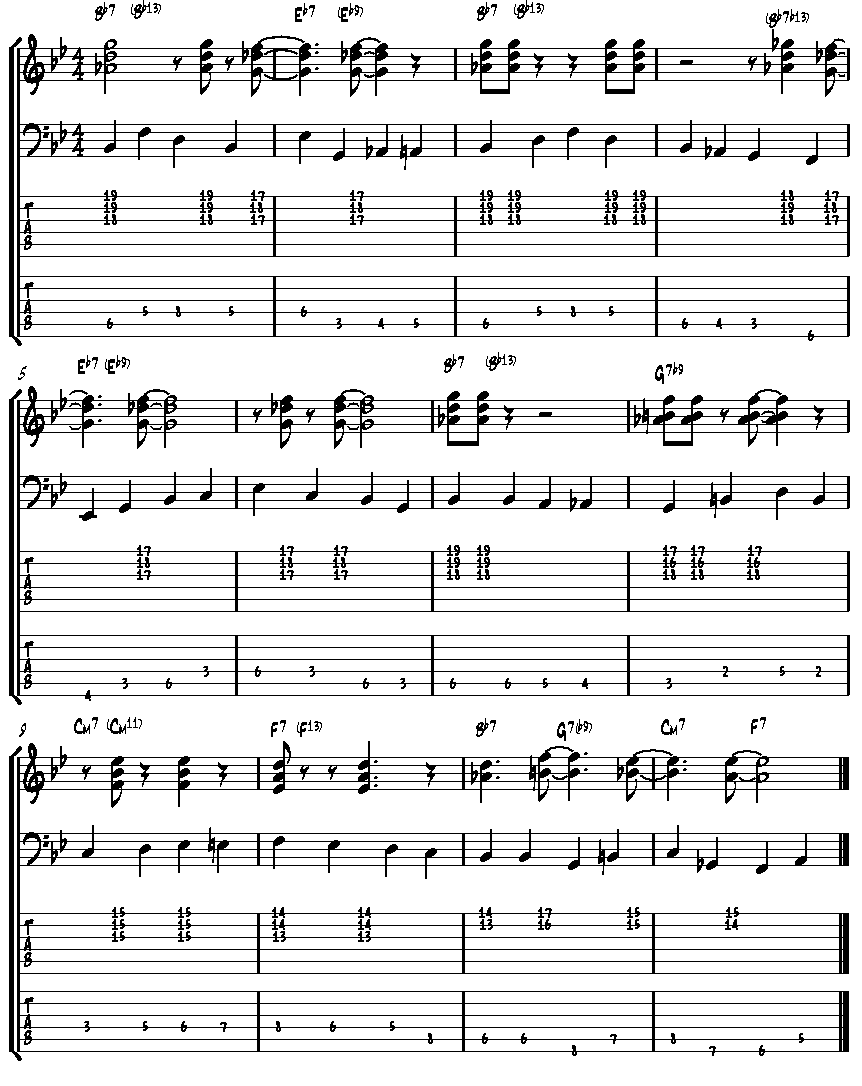Hmm….that’s better than it was before, but it still sounds pretty lifeless and boring when you hear the same rhythm played over and over again. It still definitely isn’t jazz, but we’re getting somewhere with this. Let’s think again of jazz as a language. What you just did was play a jazz “word”, but you played it over and over again. That’s the same as a person repeating the same word over and over again and expecting to make a sentence out of it. You’ll get a general gist of the subject matter, but not what they’re trying to say. For example, a sentence that reads “Apples apples apples apples apples apples” is obviously going to be about apples, just the way what you just played was “about” jazz. But what the heck is that sentence trying to convey about apples? And what the heck are you trying to convey about jazz?
You see, jazz is a genre defined by the concept of antecedent and consequence, better known as call and response. A beginning phrase is played (the call), which is followed by a contrasting phrase that provides resolution to the first (the response). This is usually understood in melodic terms, but it holds perfectly true to rhythmic work, which is what you’ll be doing here. Mix and match these phrases, elongate them, throw in flourishes of your own. Tell a story with your comping. When the soloist plays a phrase, interject with a chord at the end of the phrase. Start out with the first couple choruses with sparse accompaniment, and then build up as the soloist (or, if you’re playing solo, as you) gets more and more into the music. This is what you’re aiming to do with all of this.
To give you an idea of what I mean by all of this, here is the jazz blues chorus that we’ve been working on with a comping line that makes use of this concept of antecedent and consequence. Remember, the more rhythms and notes you play, the more the sonic space is cluttered, which can really foul up the music if the soloist needs a lot of aural room to play, so make your rhythmic choices wisely.

There are a few things you should notice. One, rhythmic anticipation is common in jazz. It is very common to play a chord on the upbeat of the fourth beat of the measure prior to its arrival, such as in measures 1, 2, 4, 7, 9, 11 and 12. Two, the rhythmic values during the turnaround (the last two measures) should be the most full so as to propel the musical movement into the next chorus. This should especially be the case when switching between soloists or heading to or out of a melody section.
OK, now we have something that sounds more like jazz, and can do for most situations. There is a certain something missing, though, and that certain something is the zesty flavor brought on by tensions. A chord is made by stacking thirds, and normally one stops stacking thirds by the time one reaches a seventh chord – 1 3 5 7. A natural tension is a chord tone that is created by stacking more thirds on top of that beyond the octave, to give you a 9, then an 11, then a 13. The two natural tensions that are the most common are the 9 and 13, which usually give chords that decidedly “jazzy” sound that we all know and love.
When applying three note chords comprised of the third, the seventh and the tension to tap comping, the most important thing to keep in consideration is the placement of notes on the D string. Here is an example of how to use chords with natural tensions in them. A slightly different walking bassline has been realized to make room for the chords with tensions. The new chords that we’re creating now are in parentheses next to the ones that they are spicing up.

Now THAT is jazzy. Map out all of the natural tensions for each chord and figure out which ones work and which ones don’t for you. The beauty of it is that each one creates dissonance in a slightly different way, and so you can pick and choose which sort of dissonance you want at any given time to help develop your unique “sound”. While six-string bassists won’t ever have quite the same sonic space on which to sprawl out as guitarists and pianists, three notes is plenty to make a mark and create grooving two-part lines that have the sound and feel of jazz. Take the examples that we’ve gone over so far and improvise around them, creating your own lines and eventually getting to the point where you can improvise a bassline and comp chords for several choruses at a time. Remember to take it slow at first – Rome wasn’t built in a day, any neither was the ability to do a technically difficult feat on the six string bass guitar. Once this method is mastered for the jazz blues, you can take other basic progressions, like Autumn Leaves, Take the A Train or Satin Doll and approach them similarly to the way we approached blues.
In the next lesson, I’ll cover basic soloing utilizing two-handed tapping. Until then, good luck with your playing!